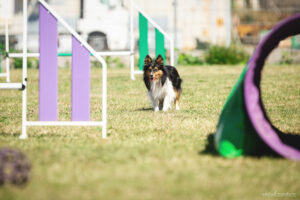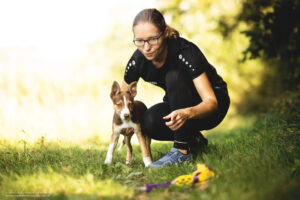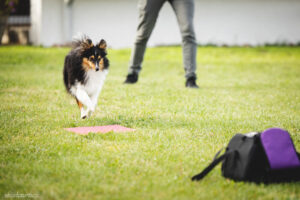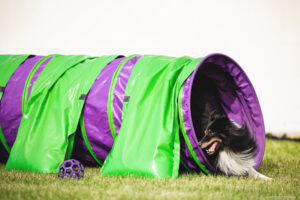Focus Cue
The foundation for successful distance work
There is no doubt that agility has changed rapidly in the last 5 years. In the past, it was still possible for a strong handler with a medium-fast dog to run everything and thus achieve a faultless run, but today this is much less possible depending on the course design and the judge. Sequences must be handled at a distance. A new type of training style in agility integrates distance work and obstacle focus into training right from the start.
Changes at all Levels
Interestingly, it is not only the highest performance class that is affected by this change. We also find significantly more distance elements in the A1 and A2. Jumps, tunnels and dogwalks are in the handler’s path and the dogs have to manuever the equipment by themselves because the handler can no longer manage to run next to every obstacle. For dogs that have been trained to read the line independently, this usually presents fewer problems because the lines follow a certain logic. This type of course is also very suitable for fast dogs with good obstacle focus.

This trend poses challenges for some handlers
It becomes problematic for 2 groups:
- More experienced, older dogs with a low focus on obstacles. In the past, it was usually possible for the handlers to run everywhere. This is often no longer possible on modern courses. In the basic training of these dogs, distance training and obstacle focus were often not yet heard of, so this concept would have to be retrained for this generation of agility dogs. However, we all know that it is always more difficult to retrain something than to build it up from the start. Especially when these teams have been running for five or more years and have come through the courses without these skills, it becomes difficult to change the focus on the handler, which has been established for years, to a focus on the obstacle and line.
- Beginner teams who teach obstacles with luring in their foundations. In the past, it was still possible to start with lower quality agility training and then switch to more professional training and be successful in competitions. Today, teams that have lured their dogs through the course by the sausage in their hand for too long will find it much more difficult to get through courses in the higher classes.
Focus & Distance Training from the Start
The consequence of this is a well-structured training with an emphasis on obstacle focus, distance exercises and understanding verbal commands. Ideally, this starts from the beginning of training. However, teams from the groups mentioned above can also achieve improvements through targeted training of these skills. The steps here should be small and your own expectations should be adapted to the dog’s learning history. So it will take some time to turn a dog that has been accompanied to every obstacle by the handler for 4 years into a dog that searches for obstacles at a distance of 6 meters.
In the following, we examine the individual elements separately.
I don’t have my own equipment 🙁
In my training, I want to convey concepts that can then be transferred to pieces of equipment. To a large extent, these concepts can be set up without equipment in a small space. Once a dog has understood the basics, it is much easier to transfer them to the equipment and to ask for the behaviors later on the course. This makes it possible to build up these skills even without your own equipment.
At what age can I start training?
As mentioned above, no obstacles are required for the basics. This has the great advantage that most of the concepts are not physically demanding and can therefore theoretically be taught to very young dogs. Of course, the dog should be mentally mature and be able to concentrate on a task. An understanding of rewards and a stay position are definitely helpful. Your dog should also have some impulse control before you start. You can find out why impulse control is important in this article.
Obstacle Focus
The obstacle focus can be started easily as a focus on a reward. The aim here is for the dog to look at a reward on a command (e.g. “focus”), but not to run to it, but to remain in the waiting position. The food machine is recommended for this, but a bowl guarded by an assistant is also possible.
The dog should already know this reward and have drive to the food machine/bowl. Then he can be restrained (on the harness) and is only released when he at least looks at the reward or perhaps even pulls towards it. If your dog is pushing forward very much, you can hold him until he relaxes a little and backs off. The focus command can now be given when the dog looks but does not pull. At this moment, we let go. After a few repetitions, a stay position can be requested (sit, down, stand). Now the dog should hold the position despite hearing the focus command and only take the reward on the release command (e.g. “Okay” or “Find it”). A very brief moment of holding back is sufficient in the beginning, so the dog should be released quickly. However, no broken stay should be rewarded.
It is good if early starts happen here at the beginning, as long as they do not lead to success, since the reward is withheld/removed. This allows the dog to develop an understanding of holding the position and focus. The interval for which the dog has to hold the focus can then be gradually extended. It is also very advisable to incorporate distracting movements by the handler while the dog is supposed to hold the focus:
Focus challenges
Can you run on the spot while your dog holds the focus? Can you do jumping jacks while your dog holds focus?
Can you stand behind your dog while he holds the focus?
Once the focus command has been established, it can be transferred to a toy reward. However, the dog should hardly make any mistakes for this, as we cannot control this reward and too many corrections can affect the drive towards the toy.
In the next step, the command is then transferred to an object. With young dogs, I like to use a dog bed that the dog already knows to go to on a verbal cue and already drives towards without it, because he has often been rewarded there. I set up the exercise in the same way and can also start by placing a cookie on the bed for the dog to focus on. Then I no longer place a reward, but send the dog to the dog bed after the focus with the command for the dog bed. In this way, the concept of “focus on reward” becomes the concept of “focus on object”.
The more objects/obstacles the dog gets to know, the more possibilities there are for using the focus command. If the dog gets to know the tunnel, the focus can be transferred to the tunnel as soon as the tunnel itself is understood as an obstacle (and the dog drives towards it). In the same way, the focus can be transferred to jump commands and all other obstacles. The concept of “object focusing” has now been extended to include obstacles as objects.
It is very important here that the dog has understood the performance of the obstacle well before we connect the obstacle to the focus command. A dog that is still turning around in the tunnel, for example, should first understand the tunnel before the focus command is added.
Distance Exercises
Once the dog has understood the focus command to look at an obstacle, the handler can move more and more at a lateral distance. Even a young dog can focus on a tunnel on the other side of the dogwalk, for example, while the handler stands 10-15 meters to the side and asks for the focus command. This helps young dogs to get used to doing a task on their own and not being accompanied to every piece of equipment. Later on, it will be natural for the dog to search for obstacles and work them independently, even at a distance, as soon as the basic understanding of the obstacle performance has been built up.
Placement of Reward
The position of the reward is important when teaching distance work. The placement of the reward should always be on the dog’s line and should not come from the handler’s hand, so that the dog is rewarded at a distance and not for coming to the handler. Additionally, a thrown reward is often not ideal, as many dogs start to look around. The timing has to be very good for the thrown reward to have the same effect as a reward that has been laid out.

Understanding Verbal Commands
The understanding of verbal commands can also be built up very well in a small area. I like to use 2 commands that the dog can master without hand signals to start with. For example, sit and a turn around yourself (e.g. “left” command) are suitable. Now the dog should distinguish between the two behaviors purely on word command. If this is already difficult, both commands should be practiced separately on the verbal cue alone. It is essential to ensure that there is no overshadowing.
This type of cue discrimination can be extended to all behaviors that our dog should learn purely on a verbal command. If the dog understands the concept of verbal discrimination in a small area, it will be easier to transfer this to the discrimination of equipment on the course later on. In this way, the dog learns to perform a (previously well known) behavior/obstacle independently of our body language.
Overshadowing
Dogs communicate largely through body language, which is why they pay much more attention to our body language than to our verbal communication. If we now give a verbal command and a physical command at the same time (for example, luring with the cookie in a circle for a left turn), the dog will always perceive the physical command more strongly and not the verbal command (which corresponds more to the human way of communicating). To speed up learning, we should therefore always give the verbal cue first and then the physical cue (the hand signal) . This allows the dog to understand the verbal command as a predictor of the physical command and he will eventually anticipate it the physical cue after the verbal cue. This is when he starts to offer the behavior on verbal cue alone.

Distance comes Naturally
Once you have built up a good focus and confidence on the obstacles, distance comes naturally and is no longer rocket science. As always in agility, the basics have to be well understood before the skills should be practiced on the course. Without basic knowledge of the concepts mentioned, a dog that is only lured into the distance with a reward (depending on disposition and experience) will find it much more difficult to learn distance work.
5 Day Indoor Challenge
You can find videos on these basics and more skills that can be prepared in the smallest of spaces in the 5 Day Indoor Challenge:
